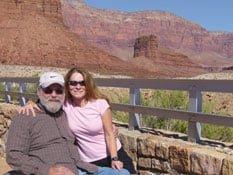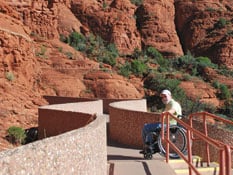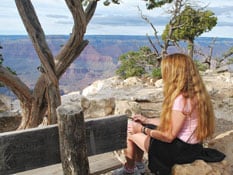
My wife, Sam, and I took a weeklong “driving vacation” in the Grand Canyon state in early October. We wanted to see as much as we could while driving no more than two to four hours per day. Our payoff was a nonstop lesson in geology and the history of the Old West — and near-perfect daytime temperatures in the 70s.
We flew in to Phoenix Sky Harbor International Airport, rented a minivan with hand controls, drove two hours in darkness to Sedona and checked into a La Quinta Inn. The room was accessible, but no roll-in shower (they put a shower seat in the tub). The next morning, opening the curtains, we might as well have been on Mars — red earth, red rocks, red sunrise.
Sedona is otherworldly in more ways than one. It hums with vortex vibes and New Age mind-expanding activities: HeartWalks (get in touch with your inner self); healing stones (please don’t throw them at the local psychics); crystals (no, you can’t snort these). Kind of like an upscale Haight-Ashbury, circa 1967.
A graying hippie wanted to photograph my aura and do a reading for $80.
“How about a discount?” I asked.
“Why a discount?”
“Half of me is paralyzed. Shouldn’t I get half off?”
The Yavapai and Tonto Apache settled near Sedona hundreds of years ago, only to be driven off later by the United States Cavalry, clearing the way for settlers to “discover” gold. Little has changed. There’s still gold to mine, but now it’s in tourists’ wallets.

Don’t let that discourage you. The air is fresh, the views inspiring, and all those red rocks take you back to a simpler time. A relaxing hourlong drive awaits you as you leave Sedona and travel up Oak Creek Canyon on your way to Flagstaff, elevation 7,000 feet, less than an hour south of the Grand Canyon.
We put the awe-inspiring canyon on hold and instead drove to Page, Ariz., gateway to Lake Powell and home of Glen Canyon Dam, which had its beginnings in 1956. When the dam was completed, it eventually flooded Glen Canyon (mostly in Utah), an area larger than Lake Tahoe, but with dozens of side canyons. The region’s most valuable resource, the Colorado River, had been captured, setting the stage for a population explosion in Phoenix, but not without a price. A beautiful canyon was now underwater.
A word about Page. If you plan on staying there, make sure you’re towing a boat, visiting someone who has one, or are prepared to rent a houseboat. Lake Powell is all there is. Of course, you can always waterski or bake in the sun, but wheelers may find themselves boat-bound while companions hike and explore. The Rainbow Bridge National Monument, a natural rock bridge that spans 278 feet and is 309 feet high, beckons, but like other natural wonders, it may be beyond reach.
The Land That John Wayne Built
Next stop, Monument Valley. A much-photographed symbol of the American West, the valley itself is encompassed within the Navajo reservation, lying in both Arizona and Utah. The View Hotel, along with Gouldings Lodge, are the only choices if you want to wake up in the heart of the valley. We stayed at The View, newly opened in 2008. Our brief time there was the highlight of our vacation. The patio of our accessible room looked out on the valley, as all rooms do.
It’s impossible to capture the effect of the landscape verbally. The best way to experience it is to drive it. An unimproved road, barely passable at times, winds its way through the valley, passing between monument-like rock formations separated by miles. Looking out on the clay-colored plain, it seems the huge towers and massive monoliths are timeless, each one unique in shape, size and character.

Drive slow and time comes to a halt. The sun, fresh air, blue sky, that fluffy cumulus cloud — everything has a way of drawing the worry right out of you. It is as if you have traveled thousands of years into the past. No houses, paved roads or telephone poles. Stop. Stop now and get out of the car. Just sit there and breathe. Feel it. This is why Native American beliefs center on the primacy of the natural world — you become part of it, and it is everything.
When we first arrived, we browsed in the hotel gift shop. References to John Wayne were everywhere — in books, toys, and knickknacks of all sorts. Adjacent to the gift shop is the hotel restaurant. I had to ask our server, Janice Smith, why the iconic actor’s name was everywhere.
“He treated our people with respect,” she said. “My husband’s grandfather, Sam Black, was befriended by him. He made several movies here. Afterwards he would come stay with Sam in his hogan, sometimes for a week, playing cards. Neither one of them spoke the other’s language. They just enjoyed being together. John Wayne came to know several of the tribal elders and made donations to help the tribe out and was well liked by the Navajo people.”
When we drove out of Monument Valley after spending a day absorbing it, we, too, had come to respect the land and its people.
Grand Canyon Grandeur
The Grand Canyon appears out of nowhere. Perhaps that’s because it took the Colorado River millions of years to carve its way through layer after layer of limestone, sandstone and other formations, eventually reaching its present depth of 6,000 feet. Our first glimpse of the canyon came all at once. Driving along, gradually ascending from the shale desert, we began noticing small evergreen shrubs, then larger trees. A sign pointed the way to the first viewpoint. We parked and wheeled right up to a massive dropoff before the canyon came into view. A crowd of multiethnic tourists just stood there, awestruck. All you could hear were cameras clicking. Hawks soared silently in the distance. At 275 miles long and up to 18 miles across, the Grand Canyon is aptly named.

It’s impossible to take in the entire canyon at any one viewpoint, so you must stop at different turnouts. We parked again at Yavapai Observation Station and took the wheelchair-accessible Rim Trail, which winds along the south rim for five miles, providing excellent views and a new “outdoor museum” which exhibits examples of rock from earlier and earlier geologic eras. As you move along the trail, you go back in time millions of years.
If you want to see the canyon from the bottom, you can get there by helicopter or mule. Or you can try something really crazy, like New Mobility’s Bob Vogel did once: You can ride your One-Off Titanium all-terrain handcycle to the bottom of a side canyon [Havasu Canyon] while lying on your stomach [“The Legend of ‘Drags Ass in Sand,’” April 2005]. Rafting in is another adventurous possibility.
A meteor crater that resembles a moonscape lies an hour’s drive from the Grand Canyon. Fifty thousand years ago a chunk of asteroid hurtled toward Earth at 26,000 miles per hour. It took only seconds to burn through the planet’s atmosphere and crash in the Arizona desert. The resulting crater is a mile across and 550 feet deep, and it’s just minutes from I-40.
All of this is in Northern Arizona, along with other wonders like Hoover Dam, the Painted Desert, the Petrified Forest and archeological ruins of the ancient Anasazi. The day before we left, Sam and I bypassed all of this and drove straight south to Tucson, in search of authentic Mexican food, a favorite of ours. Truth be told, we never found it, no doubt because we got good and lost driving at night in Tucson. Arizona is renowned for world-class stargazing, and light pollution laws have been in effect for decades. But with dim streetlights and sometimes none at all, reading street signs at night is nearly impossible.
Oh well, I guess that views of the night sky are worth preserving, too, especially when you consider that light from the stars that make up the Big Dipper, traveling at 186,000 miles per second, takes between 68 and 210 years to reach our planet.
Making Plans
• Arizona Tourism and Travel, www.arizonaguide.com.
• Sedona, www.visitsedona.com.
• Grand Canyon National Park, www.nps.gov/grca.
• Grand Canyon Tours, Hotels and Lodging, www.thecanyon.com.
• Virtual Trail of Time, http://tot.unm.edu.
• Lake Powell (Houseboat Rentals), www.lakepowell.com.
• Monument Valley, www.utah.com/monumentvalley.
• Meteor Crater, www.meteorcrater.com.
• Tucson, www.visittucson.org.
Accessible Lodging
(Moderate Cost: $100-$200 per night):
• La Quinta Inns, LQ.com (no roll-in shower).
• Courtyard by Marriott, www.marriott.com.
• Windmill Inns (Phoenix and Tucson only), www.windmillinns.com.
• The View Hotel (Monument Valley), www.monumentvalleyview.com.
• Gouldings Lodge (Monument Valley), www.gouldings.com (partially accessible).
Support New MobilityWait! Before you wander off to other parts of the internet, please consider supporting New Mobility. For more than three decades, New Mobility has published groundbreaking content for active wheelchair users. We share practical advice from wheelchair users across the country, review life-changing technology and demand equity in healthcare, travel and all facets of life. But none of this is cheap, easy or profitable. Your support helps us give wheelchair users the resources to build a fulfilling life. |


Recent Comments
Bill on LapStacker Relaunches Wheelchair Carrying System
Phillip Gossett on Functional Fitness: How To Make Your Transfers Easier
Kevin Hoy on TiLite Releases Its First Carbon Fiber Wheelchair